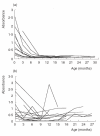Rotavirus infections and development of diabetes-associated autoantibodies during the first 2 years of life
- PMID: 12067306
- PMCID: PMC1906266
- DOI: 10.1046/j.1365-2249.2002.01842.x
Rotavirus infections and development of diabetes-associated autoantibodies during the first 2 years of life
Abstract
Rotavirus, the most common cause of childhood gastroenteritis, has been implicated as one of the viral triggers of diabetes-associated autoimmunity. To study the possible association between rotavirus infections and the development of diabetes-associated autoantibodies, we measured the prevalence of rotavirus antibodies in serum samples collected at 3-6-month intervals up to the age of 2 years from 177 children selected from consecutive newborns because they carried HLA-DQB1 alleles associated with increased risk for type 1 diabetes. Twenty-nine of the children developed at least two of four diabetes-associated autoantibodies (ICA, IAA, GADA or IA-2A) during the first 2 years of life (the cases), whereas 148 children remained autoantibody-negative matched with the cases for date of birth, gender, living region and HLA-DQB1 alleles. The temporal association between the development of the first-appearing diabetes-associated autoantibody and rotavirus infections was studied by analysing whether the cases had a diagnostic increase in rotavirus antibody titre more often during the 6-month period that preceded seroconversion to autoantibody positivity than the controls. By the age of 12 months one of the 13 case children (7%), who had a serum sample drawn at that age and who had developed at least one type of diabetes-associated autoantibodies, had experienced a rotavirus infection, while 12 of the 61 (20%) autoantibody-negative control children had had a rotavirus infection. By 18 months, four of the 22 autoantibody-positive cases (18%) and 18 of the 89 controls (20%) had rotavirus antibodies, and by the age of 24 months the respective numbers were five of the 27 cases (19%) and 32 of the 113 (28%) controls. A rotavirus infection occurred during the 6 months preceding the sample which was positive for an autoantibody in four of the 25 periods (16%) for which both necessary samples were available, while the controls had a rotavirus infection during 55 of the 370-such periods (15%). Accordingly, our data suggest that rotavirus infections are unlikely triggers of beta-cell autoimmunity in young children with genetic susceptibility to type 1 diabetes.
Figures


References
-
- Ward RL. Mechanisms of protection against rotavirus in humans and mice. J Infect Dis. 1996;174(Suppl):S51–8. - PubMed
-
- Honeyman MC, Coulson BS, Stone NL, et al. Association between rotavirus infection and pancreatic islet autoimmunity in children at risk of developing type 1 diabetes. Diabetes. 2000;49:1319–23. - PubMed
-
- McKay DM, Benjamin MA, Lu J. CD4+T cells mediate superantigen-induced abnormalities in murine jejunal ion transport. Am J Physiol. 1998;275:G29–38. - PubMed
Publication types
MeSH terms
Substances
LinkOut - more resources
Full Text Sources
Other Literature Sources
Medical
Research Materials
Miscellaneous

